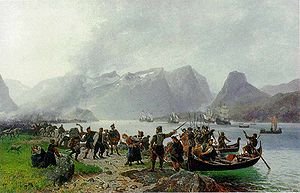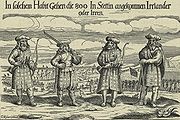.gif)
George Sinclair (mercenary)
Encyclopedia

Scotland
Scotland is a country that is part of the United Kingdom. Occupying the northern third of the island of Great Britain, it shares a border with England to the south and is bounded by the North Sea to the east, the Atlantic Ocean to the north and west, and the North Channel and Irish Sea to the...
mercenary
Mercenary
A mercenary, is a person who takes part in an armed conflict based on the promise of material compensation rather than having a direct interest in, or a legal obligation to, the conflict itself. A non-conscript professional member of a regular army is not considered to be a mercenary although he...
who fought in the Kalmar War
Kalmar War
The Kalmar War was a war between Denmark–Norway and Sweden. Though Denmark soon gained the upper hand, she was unable to defeat Sweden entirely...
, and was posthumously remembered in Norway
Norway
Norway , officially the Kingdom of Norway, is a Nordic unitary constitutional monarchy whose territory comprises the western portion of the Scandinavian Peninsula, Jan Mayen, and the Arctic archipelago of Svalbard and Bouvet Island. Norway has a total area of and a population of about 4.9 million...
. In Norway, his name is often rendered Sinklar.
Early life
George Sinclair was the illegitimate son of a CaithnessCaithness
Caithness is a registration county, lieutenancy area and historic local government area of Scotland. The name was used also for the earldom of Caithness and the Caithness constituency of the Parliament of the United Kingdom . Boundaries are not identical in all contexts, but the Caithness area is...
laird
Laird
A Laird is a member of the gentry and is a heritable title in Scotland. In the non-peerage table of precedence, a Laird ranks below a Baron and above an Esquire.-Etymology:...
, David Sinclair of Stirkoke, and nephew of the Earl of Caithness
Earl of Caithness
Earl of Caithness is a title that has been created several times in the Peerage of Scotland, and has a very complex history. Its first grant, in the modern sense as to have been counted in strict lists of peerages, is now generally held to have taken place in favor of Maol Íosa V, Earl of...
. He was educated at Edinburgh High School and in 1595 participated in a mutiny which ended after the city officers stormed the school; according to a Norwegian source Sinclair shot a bailie with a pistol.
Career

Clan
A clan is a group of people united by actual or perceived kinship and descent. Even if lineage details are unknown, clan members may be organized around a founding member or apical ancestor. The kinship-based bonds may be symbolical, whereby the clan shares a "stipulated" common ancestor that is a...
.
An early German basket hilt sword, the Sinclair hilt, was named after him due to the popularity of these weapons among Scottish mercenaries. Many of these swords were brought back to Scotland and influenced the development of the basket-hilted claymore
Claymore
The term claymore refers to the Scottish variant of the late medieval longsword, two-handed swords with a cross hilt, of which the guards were in use during the 15th and 16th centuries.-Terminology:...
, a symbol of Scotland.
Death
Sinclair's forces were taken to Norway in 1612 by the pirate Robert Stewart to fight Scotland's enemies the Danes, responsible for privateering. At the Battle of KringenBattle of Kringen
The Battle of Kringen was a battle perpetrated by a Norwegian peasant militia against Scottish mercenary soldiers who were on their way to enlist in the Swedish army for the Kalmar War....
, Sinclair was ambushed by Norwegian militia along with 300 of his men while marching through Norway to join the army of the Swedish king Gustavus Adolphus. Sinclair, riding at the head of the column and wearing a plumed helmet, was the first to fall; he was shot by Sjelstad, a Norwegian militiaman. The officers, including the expedition leader, Colonel Ramsey, were ransomed while the remaining 15 survivors were conscripted into the Danish army.
Captured Scottish weapons, including a pistol, a lochabar axe and several basket hilt claymores, were put on display at the Gudbrandsdal
Gudbrandsdal
The Gudbrandsdalen is a valley and traditional district in the Norwegian county of Oppland. The valley is oriented in a north-westerly direction from Lillehammer at Mjøsa, extending 230 km toward Romsdal...
Museum, Kvam
Kvam
Kvam is a municipality in the county of Hordaland, Norway. The parish of Vikør was established as a municipality on 1 January 1838 . Parts of Strandebarm were merged with Kvam on 1 January 1965...
, to commemorate the battle.
Sinclair's grave has become a popular tourist attraction. The incident was long remembered as a symbol of Norwegian resistance.
Legacy
Sinclair was immortalised in the poem "The Ballad of George Sinclair" translated into English from the original Danish and attributed to Oehlenschalager, Denmark's national poet.Childe Sinclair and his menyie steered
Across the salt sea waves;
But at Kringellens' mountain gorge
They filled untimely graves.
They crossed the stormy waves so blue,
for Swedish gold to fight;
May burning curses on them fall
That strike not for the right!
The horned moon is gleaming red,
The waves are rolling deep;
A mermaid trolled her demon lay -
Childe Sinclair woke from sleep.
Turn round, turn round thou Scottish youth,
Or loud thy sire shall mourn;
For if thou touchest Norway's strand,
Thou never shall return.
Henrik Wergeland
Henrik Wergeland
Henrik Arnold Thaulow Wergeland was a Norwegian writer, most celebrated for his poetry but also a prolific playwright, polemicist, historian, and linguist...
wrote a historical tragedy
Tragedy
Tragedy is a form of art based on human suffering that offers its audience pleasure. While most cultures have developed forms that provoke this paradoxical response, tragedy refers to a specific tradition of drama that has played a unique and important role historically in the self-definition of...
of the incident, Sinklars Død (Death of Sinclair), in about 1840. Wergeland also refers to the battle in his known poem Norges Fjelde (mountains of Norway), where he calls the lumber barricade used in the ambush a "barricade of freedom".

